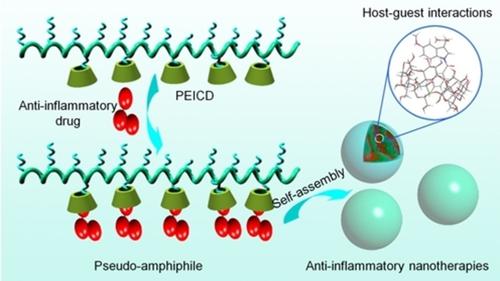当前位置:
X-MOL 学术
›
ChemistrySelect
›
论文详情
Our official English website, www.x-mol.net, welcomes your
feedback! (Note: you will need to create a separate account there.)
Facile Engineering of Anti‐Inflammatory Nanotherapies by Host‐Guest Self‐Assembly
ChemistrySelect ( IF 1.9 ) Pub Date : 2020-07-27 , DOI: 10.1002/slct.202001590 Guoyu Yang 1 , Peng Wu 2 , Cong Yu 1 , Jianxiang Zhang 2 , Jinlin Song 1
ChemistrySelect ( IF 1.9 ) Pub Date : 2020-07-27 , DOI: 10.1002/slct.202001590 Guoyu Yang 1 , Peng Wu 2 , Cong Yu 1 , Jianxiang Zhang 2 , Jinlin Song 1
Affiliation

|
Anti‐inflammatory drugs have been broadly used for the treatment of different diseases, but many of them have low water‐solubility, thereby leading to poor bioavailability and limited clinical benefits. Herein we report host‐guest assembly of nanotherapies based on different hydrophobic anti‐inflammatory drugs, in which β‐cyclodextrin (β‐CD)‐conjugated polyethyleneimine (PEICDs) were used as host polymers. The spontaneous assembly and nanotherapy formation by PEICDs was first demonstrated using a nonsteroidal anti‐inflammatory drug indomethacin, showing high loading efficiencies and loading contents. Besides inclusion interactions, hydrogen‐bonding and electrostatic forces are responsible for effective host‐guest assembly. Moreover, this facile and robust approach can be generalized to other hydrophobic drugs. Due to the amorphous distribution of loaded drug molecules in nanotherapies, they can be rapidly and completely released, with the release rate relevant to the binding free energy between drug and β‐CD. Accordingly, this host‐guest assembly strategy is promising for developing effective anti‐inflammatory nanotherapies.
中文翻译:

主客体自组装的抗炎纳米疗法的简便工程
抗炎药已被广泛用于治疗各种疾病,但是其中许多药物的水溶性低,因此导致生物利用度差,临床收益有限。本文中我们报告了基于不同疏水抗炎药的纳米疗法的宿主-客体组装,其中使用β-环糊精(β-CD)-缀合的聚乙烯亚胺(PEICD)作为宿主聚合物。PEICD的自发组装和纳米疗法的形成首先是使用非甾体类抗炎药消炎痛进行的,显示出较高的装载效率和装载量。除了夹杂物相互作用外,氢键和静电力还负责有效的客体组装。而且,这种简便而稳健的方法可以推广到其他疏水性药物。由于纳米疗法中负载药物分子的无定形分布,它们可以迅速而完全释放,释放速率与药物和β-CD之间的结合自由能有关。因此,这种宿主-客体组装策略有望用于开发有效的抗炎纳米疗法。
更新日期:2020-07-28
中文翻译:

主客体自组装的抗炎纳米疗法的简便工程
抗炎药已被广泛用于治疗各种疾病,但是其中许多药物的水溶性低,因此导致生物利用度差,临床收益有限。本文中我们报告了基于不同疏水抗炎药的纳米疗法的宿主-客体组装,其中使用β-环糊精(β-CD)-缀合的聚乙烯亚胺(PEICD)作为宿主聚合物。PEICD的自发组装和纳米疗法的形成首先是使用非甾体类抗炎药消炎痛进行的,显示出较高的装载效率和装载量。除了夹杂物相互作用外,氢键和静电力还负责有效的客体组装。而且,这种简便而稳健的方法可以推广到其他疏水性药物。由于纳米疗法中负载药物分子的无定形分布,它们可以迅速而完全释放,释放速率与药物和β-CD之间的结合自由能有关。因此,这种宿主-客体组装策略有望用于开发有效的抗炎纳米疗法。































 京公网安备 11010802027423号
京公网安备 11010802027423号